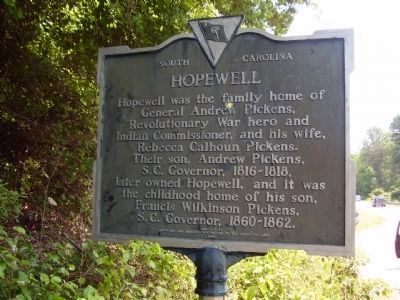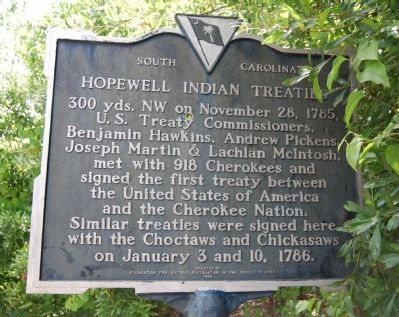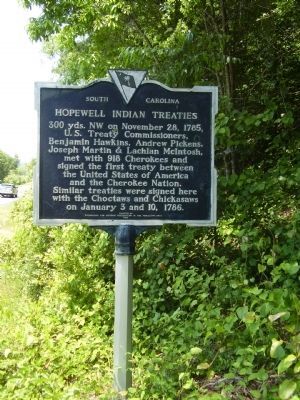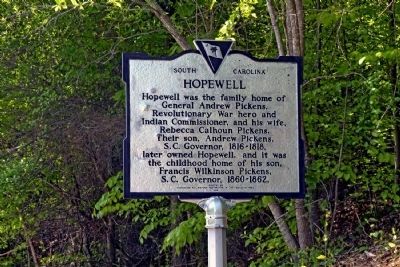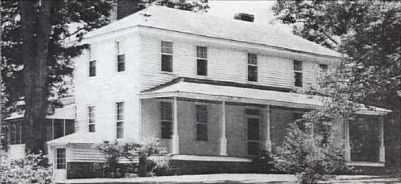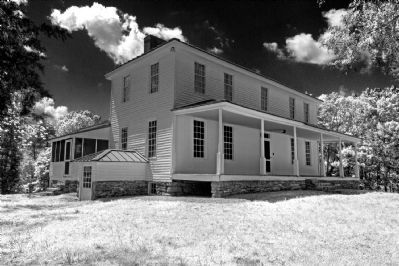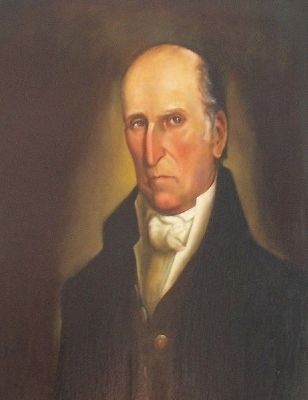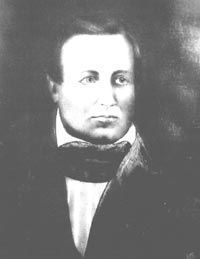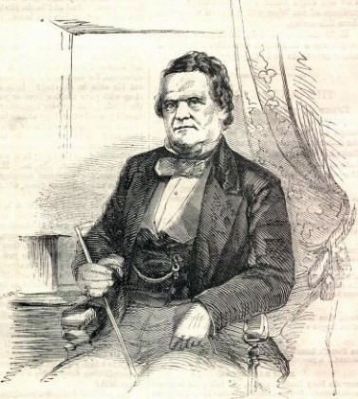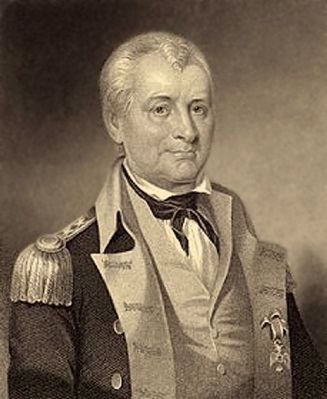Clemson in Pickens County, South Carolina — The American South (South Atlantic)
Hopewell / Hopewell Indian Treaties
Inscription.
Hopewell Indian Treaties
Erected 1966 by Foundation for Historic Restoration in the Pendleton Area. (Marker Number 39-4.)
Topics. This historical marker is listed in these topic lists: Colonial Era • Native Americans • War, US Revolutionary. A significant historical month for this entry is January 1886.
Location. 34° 39.327′ N, 82° 50.209′ W. Marker is in Clemson, South Carolina, in Pickens County. Marker is on Old Cherry Road (State Highway 149) near Camp Road (State Highway 4-56), on the left when traveling west. Marker is located in the treeline of the road. Touch for map. Marker is in this post office area: Clemson SC 29631, United States of America. Touch for directions.
Other nearby markers. At least 10 other markers are within 2 miles of this marker, measured as the crow flies. Hopewell Plantation (approx. 0.2 miles away); Hopewell Treaty Site (approx. 0.3 miles away); Hopewell, Keowee (approx. 0.3 miles away); The Battle of Seneca Town / Fort Rutledge (approx. 0.9 miles away); "Widowmaker’s” Drill (approx. 1.1 miles away); Site of Fort Rutledge (approx. 1.2 miles away); Old Stone Church / Old Stone Church Graveyard (approx. 1.4 miles away); Old Stone Church Confederate Memorial (approx. 1.4 miles away); The Old Stone Church (approx. 1.4 miles away); a different marker also named The Old Stone Church (approx. 1.4 miles away). Touch for a list and map of all markers in Clemson.
Also see . . .
1. Hopewell Plantation. Built about 1785 initially as a log structure, Hopewell Plantation is representative of a rural house type, which was common in the late 18th and early 19th century in the South Carolina backcountry. (Submitted on December 27, 2011, by Brian Scott of Anderson, South Carolina.)
2. Do you know about Hopewell?. When you think of historic houses at Clemson, Fort Hill and Hanover House spring to mind. (Submitted on December 27, 2011, by Brian Scott of Anderson, South Carolina.)
3. Hopewell Plantation - youtube video. A brief story of Gen. Andrew Pickens, his wife, Rebecca Calhoun, and their historic home in Clemson, S.C. (Submitted on July 5, 2009, by Brian Scott of Anderson, South Carolina.)
4. Andrew Pickens. Andrew Pickens (September 13, 1739 – August 11, 1817) was a militia leader in the American Revolution and a member of the United States House of Representatives from South Carolina. (Submitted on July 5, 2009, by Brian Scott of Anderson, South Carolina.)
5. Governor Andrew Pickens. Andrew Pickens, Jr. (December 13, 1779 – July 1, 1838) was an American military and political leader who served as the Democratic-Republican Governor of South Carolina from 1816 until 1818. (Submitted on July 5, 2009, by Brian Scott of Anderson, South Carolina.)
6. Francis Wilkinson Pickens. Francis Wilkinson Pickens (April 7, 1805 – January 25, 1869) was an American lawyer and politician who served as Governor of South Carolina when the state seceded from the United States during the American Civil War. (Submitted on July 5, 2009, by Brian Scott of Anderson, South Carolina.)
7. Treaty of Hopewell. The Treaty of Hopewell may refer to one of three different treaties signed at Hopewell, (the plantation of Andrew Pickens on the Seneca River in northwestern South Carolina) between the United States of America and Cherokee (1785), Choctaw
and Chickasaw (1786) indigenous nations. (Submitted on July 26, 2008, by Brian Scott of Anderson, South Carolina.)
8. Benjamin Hawkins. Benjamin Hawkins (August 15, 1754 – June 6, 1816) was an American planter, statesman, and United States Indian agent. (Submitted on December 29, 2011, by Brian Scott of Anderson, South Carolina.)
9. Lachlan McIntosh. Lachlan McIntosh (March 17, 1725 – February 20, 1806) was a British-born American military and political leader during the American Revolution and the early United States. (Submitted on December 30, 2011, by Brian Scott of Anderson, South Carolina.)
10. Cherokee. The Cherokee are a Native American people historically settled in the Southeastern United States (principally Georgia, the Carolinas and East Tennessee). (Submitted on December 30, 2011, by Brian Scott of Anderson, South Carolina.)
11. Choctow. The Choctaw (alternatively spelled Chahta, Chactas, Chato, Tchakta, Chocktaw, and Chactaw) are a Native American people originally from the Southeastern United States (Mississippi, Florida, Alabama, and Louisiana). (Submitted on December 30, 2011, by Brian Scott of Anderson, South Carolina.)
12. Chickasaw. The Chickasaw are Native American people originally from the region that would become the Southeastern United States (Mississippi, Alabama, Tennessee). (Submitted on December 30, 2011, by Brian Scott of Anderson, South Carolina.)
Additional commentary.
1. Hopewell
On July 16, 1784, General Andrew Pickens bought a tract of land near the vicinity where in 1776 a party of Whigs, under General Andrew Williamson, had been ambushed and would have been completely annihilated had it not been for the timely arrival of Pickens and his men. The deed was for "573 acres more or less bounded on west by Keowee River and all sides by vacant lands. Consideration: 57 pounds, 6 shillings." The deed was signed by Governor Benjamin Guerard with the notation that the "full cash money" has been received from the Honorable Andrew Pickens.
A lodge was built on the land. In 1785 a house, overlooking the river was completed, but it was the following summer before the family moved into it. A devout Christian and an elder in the Presbyterian Church, Pickens named the new home, Hopewell, after his church in the Long Canes.
General Pickens' home, now on Clemson University land overlooking the lake, is a two-story structure built of large hand hewn logs overlaid with weather-boarding. A porch extends across the front of the house. The house has wide halls with two large rooms on either side. The large doors, mantels and panelled walls are very old and beautifully made. Beneath the house is a large basement room made of native stones with a grand fireplace.
Situated, as it was, on the frontier and near the boundary of the Cherokee Nation, Hopewell is rich in Indian history. On March 21, 1785, Congress appointed Pickens on a commission to treat with the Southern Indians - a position he held for nearly twenty years. From November 22, 1785 until January 10, 1786 the Indians from the Cherokee, Choctaw, and Chickasaw nations met consecutively with the United States Commissioners at Hopewell. Treaties, known hereafter as the Hopewell Treaties, were signed by the commissioners and the leading chiefs of the nations.
During the time that General Pickens made his home at Hopewell, he served in the State Legislature; Congress; and in 1812, after he had consented to run for governor, he withdrew from the race saying he believed the running of the government should be left to younger and more active men. Hopewell was also the home of the son, Ezekiel, who served as lieutenant governor (1802-1804); and Andrew Jr., who was governor of South Carolina from 1816-1818. When the General moved to Tamassee in the spring of 1805, he gave Hopewell to his sons, Ezekiel and Andrew. Andrew, who had married Susan Smith Wilkinson, lived in the family home and it was there than his son, Francis (born April 7, 1805) spent his childhood. He, too, served in the State Legislature, Congress, Minister to Russia, and was Secessionist governor of South Carolina, 1860-1862. Thus we find that Hopewell housed three generations of the Pickens family who served their country and state faithfully and well.
Ezekiel Pickens, Andrew's older brother, who served as lieutenant-governor of S.C. (1802-1804) also spent much time at Hopewell. Ezekiel owned another house (sometimes called "The Cottage") on his part of the "Hopewell settlement," south of Andrew's plantation. Ezekiel's house was still standing in the 1930s but is gone now.
General Andrew Pickens' wife, Rebecca Colhoun, was the sister of Senator John Ewing Colhoun, father of Mrs. John C. Calhoun, and it was really the Senator who, in the 1790s, had brought the Calhoun family into this area. He was doubly related to the Pickens since his wife's sister (Elizabeth Bonneau) married his nephew, Ezekiel Pickens. After "Betsy" Bonneau Pickens' death, Mrs. Floride Bonneau Calhoun brought up Ezekiel's daughter, Elizabeth, as though she were her own child and sister of her daughter, Floride. Elizabeth Pickens married Patrick Noble, who became Governor of South Carolina 1838-1840, and wife of the Vice-President of the United States. Ezekiel Pickens married a second time, Elizabeth Barksdale
(Mrs. Eliza Pickens), who lived until 1859, so that Ezekiel's part of the Hopewell property of his father remained in the family long after Andrew's "Hopewell Plantation" has been sold.
In 1824, after moving to Alabama, Andrew sold his land to Congressman John Carter of Camden. Carter's brother-in-law, Horace Reese, had arranged to buy the property in 1829 and after his death the transaction was completed by Charles M. and George Reese, Jr. (nephews of the beloved Rev. Thomas Reese). The Reeses advertised the property for sale in the Pendleton Messenger as "Hopewell Plantation, lying on both sides of Seneca River, 11,000 acres. Large dwelling house. Ferry boat."
In 1835 it was advertised again by David Cherry (who married Mary Story Reese, daughter of George Reese, Sr.): "...lying on both sides of Seneca River, known by the name of Hopewell, the former residence of Gen. Andrew Pickens..." David Cherry bought the property himself and it became known as "the Cherry Place."
At this time (1835) a plat made by Martin S. McCay, preserved in the Pickens County Courthouse, Book C, page 176) shows the general location of the house, the ferry across the Seneca River and the road to Pendleton, which would have been part of the famous "General Pickens wagon road" to Abbeville, the best-known road in the area. (Source: Pendleton Historic District: A Survey
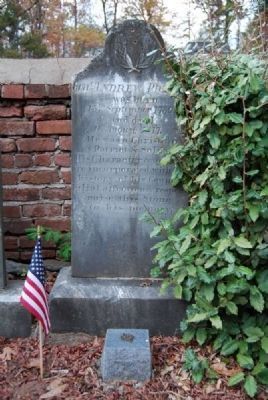
Photographed By Brian Scott, November 28, 2028
8. Gen. Andrew Pickens Tombstone
Old Stone Church Cemetery, Clemson, SC
Old Stone Church Cemetery, Clemson, SC
was born
15th September 1739
and died
11th August 1817.
He was a Christian
a Patriot & Soldier.
His Character & age
are incorporated with the
history of his Country.
Filial affection & respect
raise this Stone
to his memory.
— Submitted July 5, 2009, by Brian Scott of Anderson, South Carolina.
2. Andrew Pickens (1739-1817)
Andrew Pickens, (grandfather of Francis Wilkinson Pickens), a Representative from South Carolina; born in Paxton, Bucks County, Pa., September 13, 1739; attended the common schools; moved with his parents to the Waxhaw settlement in South Carolina in 1752; served in the provincial militia in the campaign against the Cherokee Indians in 1760; entered the Revolutionary Army as captain of militia and attained the rank of brigadier general; commanded an expedition against the Cherokee Indians in 1782; member of the state house of representatives 1781-1794; one of the commissioners named to settle the boundary line between South Carolina and Georgia in 1787; member of the state constitutional convention in 1790; elected as an Anti-Administration candidate to the Third Congress (March 4, 1793-March 3, 1795); appointed major general of militia in 1795; unsuccessful candidate for election to the United States Senate in 1797; member of the state house of representatives 1800-1812; declined the nomination for governor in 1812; died in Tomassee, Pendleton District, S.C., August 11, 1817; interment in Old Stone Churchyard,
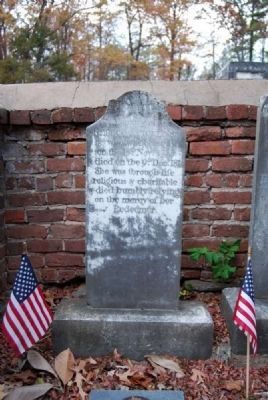
Photographed By Brian Scott, November 28, 2028
9. Rebecca Calhoun Pickens Tombstone
Old Stone Church Cemetery, Clemson, SC
Old Stone Church Cemetery, Clemson, SC
on the 18th Nov. 1746
& died on the 9th Dec. 1814.
She was through life
religious & charitable
& died humbly relying
on the mercy of her
Redeemer.
-----
Wife of
General Andrew Pickens
— Submitted July 5, 2009, by Brian Scott of Anderson, South Carolina.
3. Francis Wilkinson Pickens (1805-1869)
Francis Wilkinson Pickens, (grandson of Andrew Pickens), a Representative from South Carolina; born on a plantation on the Toogoodoo River, St. Paul’s Parish, Colleton District, S.C., April 7, 1805; completed preparatory studies; attended Franklin College, Athens, Ga., and was graduated from South Carolina College (now the University of South Carolina) at Columbia; studied law; was admitted to the bar and commenced practice in Edgefield District in 1829; engaged in planting; member of the state house of representatives 1832-1833; elected as a Nullifier to the Twenty-third Congress to fill the vacancy caused by the resignation of George McDuffie; reelected as a Nullifier to the Twenty-fourth and Twenty-fifth Congresses and elected as a Democrat to the Twenty-sixth and Twenty-seventh Congresses and served from December 8, 1834, to March 3, 1843; chairman, Committee on Foreign Affairs (Twenty-sixth Congress); member of the state senate 1844-1846; member of the Nashville southern convention in 1850; delegate to the Democratic National Convention in 1856; unsuccessful candidate for the United States
Senate in 1857 to fill the vacancy caused by the death of Andrew P. Butler; Minister to Russia 1858-1860; governor of South Carolina 1860-1862; died in Edgefield, Edgefield County, S.C., January 25, 1869; interment in Edgefield Cemetery. (Source: Biographical Directory of the U.S. Congress.)
— Submitted July 5, 2009, by Brian Scott of Anderson, South Carolina.
4. Benjamin Hawkins (1754 - 1818)
Benjamin Hawkins, (uncle of Micajah Thomas Hawkins), a Delegate and a Senator from North Carolina; born in what was then Granville, later Bute, and now Warren County, N.C., August 15, 1754; attended the county schools; student at the College of New Jersey (now Princeton University) when the Revolutionary War began; acquired a knowledge of French, and, at the request of General George Washington, left school and was appointed to the General’s staff as his interpreter; member, State house of commons 1778-1779, 1784; chosen by the North Carolina legislature in 1780 to procure arms and munitions of war to defend the State; Member of the Continental Congress 1781-1783 and 1787; appointed by Congress to negotiate treaties with the Creek and Cherokee Indians in 1785; delegate to the State constitutional convention which ratified the Federal Constitution in November 1789; elected to the United
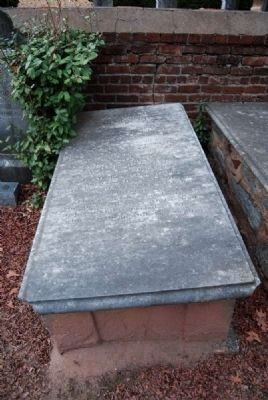
Photographed By Brian Scott, November 28, 2008
11. Gov. Andrew Pickens Tombstone
Old Stone Church Cemetery, Clemson, SC
Old Stone Church Cemetery, Clemson, SC
and died July 1, 1838.
He was the son of
Gen. Andrew Pickens
of South Carolina.
In the War of 1812 he did his duty
to his country as a Lieut. Col.
with the Army on the Canada Frontier
where he was appointed to Command
one of the Regiments of State troops
raised in South Carolina,
and was in 1817 elected
Governor of this State.
In all the various stations
he was asked to fill
he discharged his duty with honor
and fidelity.
Full of Justice and Truth,
he died at peace with his God,
beloved and respected by those
who were near and dear to him.
— Submitted December 30, 2011, by Brian Scott of Anderson, South Carolina.
Credits. This page was last revised on September 17, 2020. It was originally submitted on July 26, 2008, by Brian Scott of Anderson, South Carolina. This page has been viewed 4,405 times since then and 127 times this year. Photos: 1. submitted on May 9, 2011, by Stanley and Terrie Howard of Greer, South Carolina. 2. submitted on July 26, 2008, by Brian Scott of Anderson, South Carolina. 3. submitted on May 9, 2011, by Stanley and Terrie Howard of Greer, South Carolina. 4. submitted on December 25, 2013, by William Henry Myers III of Seneca, South Carolina. 5. submitted on July 5, 2009, by Brian Scott of Anderson, South Carolina. 6. submitted on December 25, 2013, by William Henry Myers III of Seneca, South Carolina. 7. submitted on March 17, 2009, by Mike Stroud of Bluffton, South Carolina. 8. submitted on July 4, 2009, by Brian Scott of Anderson, South Carolina. 9. submitted on December 27, 2011, by Brian Scott of Anderson, South Carolina. 10, 11. submitted on December 28, 2011, by Brian Scott of Anderson, South Carolina. 12. submitted on July 5, 2009, by Brian Scott of Anderson, South Carolina. 13, 14. submitted on December 30, 2011, by Brian Scott of Anderson, South Carolina. • Kevin W. was the editor who published this page.
